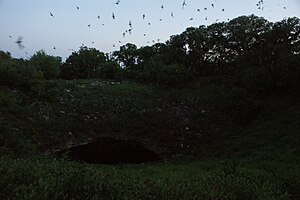
Bats have faced several threats throughout their existence, one of the most predominant being humans and side effects of human actions. In North America that is no longer the case, and bats are facing their most serious threat yet!
“…instead of sticking up for the little browns who get into people’s houses against big hulking homeowners who traditionally leap around trying to clobber them with tennis rackets, I am wringing my hands over a plight that affects many more of the little insectivores. I’m talking about the white nose fungus disease that has so depleted our bat population…” (Lake Placid News)
White-nose Syndrome Threatens North American Bats
I’ve noticed fewer bats in recent summers, and now I know that the cause of the recent bat population decline in the eastern United States can be attributed to White-nose syndrome (WNS). In January of this year, the U.S. Fish and Wildlife Service announced that the disease has so far killed 5.7 to 6.7 million bats (in only 6 years)!
“First found in 2006 on bats in a cave in Schoharie County, NY, the disease has since been found in more than 115 caves and mines as far north as Quebec, Canada, and as far south as North Carolina. In February 2012, new cases appeared in northeastern Ohio.” (Examiner.com)
The syndrome, so-called because affected bats often have a white fungus on their muzzles, attacks hibernating bats. The disease is harmless to humans, but bats experience a “loss of body fat, damage to the membranes in their wings, and unusual behavior in winter, including restless hibernation” (Examiner.com).
Essentially the bats awaken too early and too often during winter and use up their fat stores, and with no food available they starve to death or freeze while searching for food.

Some of the bats are killed more quickly as oxygen supplies are choked off, wing tissues die, and dehydration sets in. Many dead bats are found emaciated (Adirondack Explorer).
In some colonies the population has been completely eradicated. The U.S. Fish and Wildlife Service calls “WNS a wildlife health crisis and is considering extending endangered-species protection to little brown, northern, and eastern small-footed bats” (Adirondack Explorer).
“The disease appears to spread via bat-to-bat contact, making it particularly hard to control. Scientists also have found that the fungus travels in soil, which indicates that it’s possible for humans to carry the fungus from one cave or area to another on their shoes or clothing.” (Examiner.com)
The disease has been traced to Europe, where the bats there are immune, but no cure or cause for the immunity has yet been found (Guardian News).
How Can You Help?

Spreading awareness of the disease is crucial! Be aware and report bats to the DEC if you see them in bad condition or behaving unusually.
It’s also helpful to donate money to nonprofit organizations that focus on bat conservation or speleological groups concerned about caves.
Most importantly, people should be staying out of caves and mines to reduce human contact with the fungus and the possibility of spreading it!
Go to White-Nose Syndrome.org to learn more.
The Future of Adirondack Bats
Scientists are searching for a cure, but so far no luck. If a chemical solution is found implementing it would be another hardship because of the factor of the chemical negatively affecting other wildlife.
Some of the possible options to save our bats include:
- Captive propagation–Bats would be bred, kept in captivity, and eventually released into the wild.
- Capture bats as they enter caves, clean them off, and transport them to an artificial site for hibernation, and then release healthy in spring.
- Cryopreservation: freezing eggs, sperm, or tissues to enable future in-vitro reproduction of bats. (Adirondack Explorer)
“At the moment, the best hope is that bats will develop a way of dealing with the disease on their own, whether that comes from an immune-system response, behavioral changes, or a combination of the two. Survivors that are immune may produce offspring that are resistant, and the population may eventually rebound.” (Adirondack Explorer)
Related articles







I have never understood why people are so terrified of bats! They do so much good in our ecosystem, and much like snakes – are loathed and killed by humans who have no understanding of the role they play in nature. Besides, both bats and snakes would much rather get out of your way than bite you!
I hope the little critters survive and thrive! Cheers, Beth Lawrence, Viva La Voice
I’m with you, Beth. Bat lovers (tolerators?) unite! It is sort of curious how startled we can be when bats swoop by in the inky dark, perhaps even grazing us on the way past… So much that folklore. Hopefully white nose syndrome has heightened our sensitivity to bats, and perhaps we will all be into appreciate how effective they are controlling the noise some mosquito situation.
I’m not sure why so many people dislike bats either. Just no desire to learn or understand, and simply accepting the bad reputation given by folklore and Hollywood is I imagine a part of the problem.